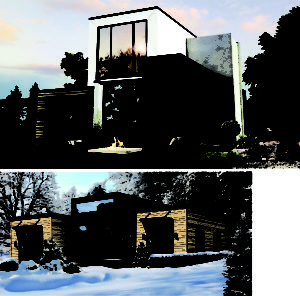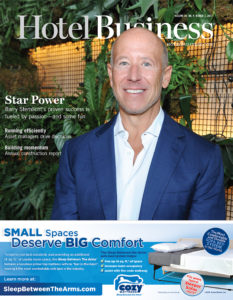
TOP TO BOTTOM: The Cortina and Meribel minilofts are among the next group of units available to book.
MONT-TREMBLANT, QUEBEC, CANADA—Situated on 543 acres about 80 miles north of Montreal and a short distance from the popular Tremblant ski area, Bel Air Resort & Residences is a work-in-progress mixed-use project that, when finished, will include a 79-acre hospitality component as well as 140 homes.
When construction is complete, for which a timetable has yet to be set, 90 units called minilofts will be scattered around the forest-like terrain of the resort located within the Laurentian Mountain range. The minilofts—two-, three- and four-bedroom house-like structures—will be available to book for daily, weekly and long-term stays. Currently, there are four two-bedroom units open for two-day-minimum stays. The Stowe miniloft in November was voted by TripAdvisor as one of the 10 prettiest alpine chalets in the world.
The resort’s miniloft concept is the brainchild of Frenchman Eric Harari, a Miami-based entrepreneur who spent the last two decades in the vacation rental business in the South Florida city.
“The idea was to build something different, where people can come back to nature,” said the Bel Air founder. “They want something organic, a different kind of experience. We felt that building houses would provide a different experience than a hotel. Also, the land is so big that it gave us the ability to place them in a very smart way.”
He noted that he became familiar with Mont-Tremblant on a ski trip 20 years ago. “I fell in love with the area, the space and the nature,” he said. “It’s just incredible with the surrounding lakes and the old trees. Then, I had a chance to buy this big piece of land where nothing was touched.”
Construction on the first four minilofts was completed in January 2015. Harari explained that eco-friendly techniques were implemented during the process, from the materials to where the units were built.
“The position of the minilofts, which are oriented toward the sun, will reduce the use of energy,” he said, adding, “We used the latest construction techniques to keep the house warmer in the winter and to keep the heat out in the summer, such as extra foam insulation and low-emissivity windows.”
He continued, “There was so much wood around us that we decided to source all of the wood locally to reduce the impact [on the environment]. The area also has a lot of mines where we could source the rocks for the construction of the roads.”
The way they are being built also creates less impact on the environment. “Our suppliers are bringing the walls already insulated and cut with the openings for the windows,” Harari said. “From a sustainability standpoint, the walls are not built outside. They come precut and just need to be assembled, and it all gets constructed in a day on top of the foundation. Normally, there is a lot of waste during construction. When it is standardized, there isn’t much waste because we know all of the dimensions.”
He added, “It’s more like an assembled house than a prefab, which is an advantage because there is some latitude as far as sizes. When you do prefab, you have to transport whatever you build. You are limited by your space.”
Four more minilofts are currently under construction: the two-bedroom Aspen and Vail models, as well as the two-story Cortina and Meribel units, with three and four bedrooms, respectively. They are expected to be completed sometime later this month. Work will then commence on a dozen more minilofts, which are expected to be completed by September.
The minilofts, ranging from 1,000-1,600 sq. ft., feature a modern, minimalist approach, according to the resort, and offer all of the amenities of an extended-stay hotel with a few added touches. They come with floor-to-ceiling windows; fully equipped kitchens; a washer and dryer; a dining area; a master bedroom with en-suite bathroom; another full bathroom; and flat-screen TVs in the bedrooms and living room. Wireless internet is also available. Those already built also offer a grill and fire pit for each unit, while a shared hot tub sits between two minilofts.
Harari noted that each model features smart technology that can be found in conventional hotels, including automatic thermostats and curtains. He also said that there are plans to build minilofts that are 100% fully independent, using solar panels and recycled water.
Also under construction is the 7,000-sq.-ft. clubhouse, which Harari expects will be finished in June. “We are now putting in the interior walls, windows and roof,” he said. “At the ground level, there will be a reception desk, lounge and a health bar offering salads, organic soups and other healthy items. On the top floor will be a 400-sq.-ft. fitness center, yoga studio, a spa area for treatments, a whirlpool tub and sauna. Underground, we are building a room for kids where babysitters can take care of them if their parents want to go somewhere.”
He added, “We are also building a pool and, once the snow melts, we will be building about six miles of trails throughout the property where guests can walk, bike and run.”
The clubhouse will also feature a multifunction conference room for large meetings, but small groups will also be able to use one of the freestanding office pods that will be scattered around the building. The 50-sq.-ft. units will feature a desk, phone, WiFi, computer and printer.
Harari said that he’d like to, down the line, add electric-car charging stations.
Down the mountain, on a flat area of land, is what is being called The Prairie. It is expected to include tennis, volleyball and basketball courts, as well as an archery range. Harari said that he’d like to add an eco-friendly component to The Prairie as well.
“At the bottom of the prairie, in a year-and-a-half or two years, I would like to have a farm with some cows and chickens,” he said. “I would like to have guests come with their kids to get milk from the cows and eggs from the chickens.” He added that he’d also like to add containers to grow aeroponic food.
When the resort is finished, Harari expects there to be “50% four-bedroom units, 35% three-bedroom and the rest two-bedroom.”
He added, “We have the ability to do whatever we want. We don’t want to compete with hotels. We want to offer a very different experience. Taking into account the hotel competition, I know that a four-bedroom unit doesn’t really exist. The other competition may be vacation rentals, but in Mont-Tremblant, as it is everywhere else, they don’t do short-term rentals. With this project, we have secured the right to do short-term rentals.” HB

